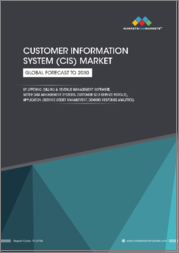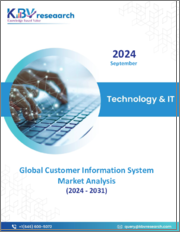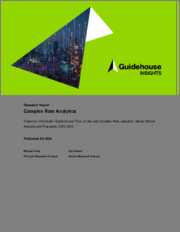
|
시장보고서
상품코드
1827177
고객 정보 시스템 시장 : 구성요소별, 전개 형태별, 기업 규모별, 용도별, 최종 용도별 - 세계 예측(2025-2032년)Customer Information System Market by Component, Deployment Mode, Enterprise Size, Application, End-Use - Global Forecast 2025-2032 |
||||||
고객 정보 시스템 시장은 2032년까지 CAGR 7.65%로 36억 8,000만 달러에 이를 것으로 예측됩니다.
| 주요 시장 통계 | |
|---|---|
| 기준 연도 2024년 | 20억 4,000만 달러 |
| 추정 연도 2025년 | 21억 8,000만 달러 |
| 예측 연도 2032 | 36억 8,000만 달러 |
| CAGR(%) | 7.65% |
고객 경험 최적화 및 업무 현대화에서 전략적 역할에 대한 개요, 최신 고객 정보 시스템에 대한 종합적인 방향성 제시
고객 정보 시스템(CIS)은 유틸리티 기업 및 관련 서비스 제공업체에게 고객 참여, 업무 최적화, 규제 준수의 교차점에 위치합니다. 최신 CIS 플랫폼은 단순한 과금 엔진에서 계량기 데이터를 통합하고, 고급 서비스 주문 관리를 지원하며, 자동화된 과금 및 결제 워크플로우를 가능하게 하고, 고객 데이터 저장 및 검색을 위한 단일 창을 제공하는 통합 에코시스템으로 진화하고 있습니다. 이러한 진화는 조직이 고객 경험, 업무 효율성, 기술 우선순위에 접근하는 방식을 재구성했습니다.
디지털 전환 프로그램이 성숙해짐에 따라, 이해관계자들은 CIS 투자가 직접적인 비즈니스 혜택과 지속적인 혁신의 토대가 될 것으로 기대하는 경향이 높아지고 있습니다. 계량기 데이터 플랫폼과의 통합, 서비스 주문의 원활한 오케스트레이션, 강력한 결제 자동화는 더 이상 선택적 기능이 아니라 전화 통화 횟수 감소, 신속한 문제 해결 및 수익 보장을 목표로 하는 유틸리티 기업의 핵심 요구사항이 되었습니다. 따라서 CIS 이니셔티브는 지속적인 가치를 실현하기 위해 명확한 성공 지표, 리스크 완화 계획, 그리고 부문 간 거버넌스를 통해 계획되어야 합니다.
융합하는 기술, 규제 요건, 진화하는 고객 기대에 따라 CIS 플랫폼의 운영 아키텍처와 전략적 우선순위가 빠르게 재정의되고 있습니다.
새로운 기술, 규제 기대, 고객 행동의 수렴에 따라 고객 정보 시스템 환경은 빠르게 변화하고 있습니다. 클라우드 네이티브 도입 모델은 보다 빠른 기능 제공과 분산된 리소스와의 손쉬운 통합을 가능하게 하며, 고급 분석 및 AI는 예측적 인사이트를 제공하고 일상적인 의사결정을 자동화하기 위해 운영 워크플로우에 통합되고 있습니다. 이러한 변화로 인해 기업은 레거시 아키텍처를 재평가하고, 새로운 기능을 도입하면서도 핵심 업무의 연속성을 유지할 수 있는 단계적 마이그레이션 전략을 고려해야 합니다.
동시에 옴니채널 인게이지먼트에 대한 고객의 기대는 통합 데이터 모델과 API 우선 플랫폼에 대한 투자를 촉진하고 있습니다. 아키텍처와 서비스 제공업체는 실시간 계량기 데이터 통합에 대한 요구와 기존 과금 주기의 완만한 케이던스를 조화시켜야 하며, 미들웨어와 이벤트 기반 아키텍처가 점점 더 일반적인 패턴으로 자리 잡고 있습니다. 데이터 프라이버시, 청구의 정확성, 공정한 서비스 제공에 대한 규제 압력은 기술 혁신을 방해하지 않고 감사 가능성과 구성 가능성을 입증할 수 있는 시스템의 필요성을 더욱 가속화합니다.
2025년 관세 개정이 고객 정보 시스템 구상의 조달 전략, 공급업체 선정, 도입 순서에 어떤 영향을 미쳤는지 이해합니다.
2025년 관세 및 무역 정책 조정으로 인해 조달, 공급망 계획, 기술 이니셔티브의 수명주기 비용 분석에 새로운 변수가 도입되었습니다. 이 시기에 고객 정보 시스템을 도입하거나 업그레이드하는 조직은 벤더의 비용 구조 변화와 하드웨어 의존성 구성요소의 리드 타임이 길어지면서 도입 순서와 벤더 선정 기준에 영향을 미치고 있습니다. 이러한 역학관계는 조달 전략을 정의할 때 계약상의 유연성과 공급업체 다변화의 중요성을 강조하고 있습니다.
실제로 조달팀은 온프레미스 하드웨어 의존도를 최소화한 클라우드 네이티브 소프트웨어에 우선순위를 두고, 관세 관련 비용 변경에 대한 보다 명확한 패스스루 조항을 협상하고, 타사 공급업체의 발자국을 더 면밀히 조사하는 방식으로 대응해 왔습니다. 프로젝트 관리자는 벤더의 지연을 관리하기 위해 컨틴전시 플랜을 검토하고, 프로젝트 타임라인을 지키기 위해 변경 관리 프로세스를 강화하고 있습니다. 운영 측면에서는 서비스의 연속성을 유지하고 관세로 인한 비용 변동이 고객 대응 기능과 규제 준수 의무를 손상시키지 않도록 하는 데 주력하고 있습니다.
구성요소, 배포, 기업 규모, 용도, 최종 용도 차원이 CIS의 우선순위와 아키텍처 선택을 결정하는 방법을 보여주는 세분화에 기반한 심층적인 인사이트 제공
세분화 분석을 통해 기능, 배포, 조직, 용도, 최종 용도 등 다양한 관점이 고객 정보 시스템 분야의 우선순위와 투자 패턴을 어떻게 형성하는지 파악할 수 있습니다. 구성요소를 고려할 때, 소프트웨어 투자는 구성 가능한 API 지향 모듈에 중점을 두고, 서비스는 매니지드 서비스와 전문 서비스로 구분되며, 구매자는 운영 아웃소싱과 사내 역량 구축을 비교 검토합니다. 클라우드 기반 모델과 온프레미스 모델 중 어느 쪽을 선택하느냐에 따라 통합 접근 방식, 복원력 계획, 총비용에 대한 의사결정이 필요하며, 하이브리드 아키텍처에 대한 명확한 로드맵이 필요합니다.
대기업은 확장성, 멀티 리전 컴플라이언스, 레거시 업무 시스템과의 복잡한 통합을 우선시하고, 중소기업은 빠른 Time-to-Value, 관리 용이성, 예측 가능한 비용 구조를 중요시합니다. 청구 및 결제 자동화, 커뮤니케이션 도구, 고객 데이터 저장 및 검색, 계량기 데이터 통합, 서비스 주문 관리 등 용도별로 세분화함으로써 단일 모듈이 보편적으로 지배적이지 않고, 최적의 아키텍처는 운영 및 고객 경험 목표를 달성하기 위해 이러한 기능의 균형을 맞추는 것임을 알 수 있습니다. 고객 경험의 목표를 달성하기 위해 이러한 기능의 균형을 맞추는 것이 최적의 아키텍처임을 강조합니다. 마지막으로, 전력 및 전력 관리 유틸리티, 가스 유틸리티, 정부 기관, 재생에너지 유틸리티, 상하수도 관리 유틸리티의 최종 사용처에 대한 검토는 규제 제약, 계량기 기술, 고객 참여 모델을 결정하고, 이는 구현 순서와 사용자 정의 선택에 영향을 미칩니다.에 영향을 미칩니다.
CIS의 조달, 배치 및 컴플라이언스 전략을 형성하는 아메리카, 유럽, 중동 및 아프리카, 아시아태평양의 지역적 고려사항 및 시장 역학
지역적 역동성은 고객 정보 시스템의 기술 선택, 규제 준수, 파트너십 모델에 강력한 영향을 미칩니다. 아메리카 대륙의 바이어들은 일반적으로 고객 경험 향상과 규제 당국 보고와 같은 성과를 중시하며, 빠른 혁신 주기와 강력한 공급업체 지원 생태계를 가능하게 하는 솔루션을 선호합니다. 이 지역의 경쟁 상황과 디지털 서비스에 대한 고객의 높은 기대치를 반영하여, 이 지역의 상황은 통합과 확장을 위한 명확한 로드맵을 가진 상업적으로 성숙한 제품을 요구하는 경우가 많습니다.
유럽, 중동 및 아프리카에서는 규제 체계와 데이터 보호 기준이 복잡한 운영 환경을 조성하고 있으며, 설정 가능성과 엄격한 감사 추적이 중요하게 평가되고 있습니다. 또한, 여러 나라에 걸쳐 전개되는 경우, 공통된 기능과 각 지역의 적응성의 균형을 맞추기 위해 모듈식 접근 방식이 필요한 경우가 많습니다. 아시아태평양에서는 시장 성숙도가 다양하며, 빠르게 현대화하는 전력회사가 클라우드 우선 전략과 고도의 계량기 통합을 채택하는 반면, 제약이 많은 인프라에 대한 실용적이고 비용 중심의 구현을 우선시하는 시장도 공존하고 있습니다. 이러한 지역적 뉘앙스의 차이로 인해 유연한 상업적 모델, 지역별 전달 방식, 세계 역량과 지역적 실행을 연결하는 파트너십이 요구됩니다.
유틸리티를 위한 소프트웨어, 매니지드 서비스, 통합 도입의 성공적 제공, 경쟁에서 중요한 차별화 요소와 벤더의 행동
주요 벤더와 시스템 통합업체들은 전문성, 플랫폼의 개방성, 탁월한 제공의 조합을 통해 차별화를 꾀하고 있습니다. 모듈식 아키텍처와 풍부한 통합 프레임워크에 투자하는 기업은 커스터마이징 오버헤드를 줄이고, 계량기 데이터 플랫폼, CRM 시스템, 분석 도구와의 상호운용성을 가속화하여 고객 가치 실현 시간을 단축할 수 있습니다. 전략적 제휴와 파트너 에코시스템은 벤더의 로드맵을 강화하고, 미터 데이터 통합, 서비스 주문 오케스트레이션, 결제 컴플라이언스 등의 분야에 특화된 기능을 제공합니다.
고객 대응의 성공 여부는 입증된 구현 방법론, 변경 관리 능력, 유사한 유틸리티 부문에서 참조할 수 있는 성과에 의해 점점 더 많이 좌우되고 있습니다. 소프트웨어와 동시에 매니지드 서비스를 제공하는 벤더는 예측 가능한 서비스 수준을 제공하는 대신 운영 리스크를 감수하면서 더 큰 경상적 가치를 얻을 수 있습니다. 또한, 현지화 된 배송을 제공하고 여러 관할권에서 컴플라이언스를 지원할 수 있는 능력은 대규모 배포에서 차별화 요소가 될 수 있습니다. 전문 서비스, 교육에 대한 투자, 잘 문서화된 API 표면은 이 분야에서 가장 성공적인 공급업체들의 공통된 특징입니다.
CIS 환경의 현대화를 목표로 하는 리더들이 도입 위험을 최소화하고 변화에 대한 수익을 극대화할 수 있도록 실행 가능한 전략 및 조달에 대한 권장 사항을 제공합니다.
업계 리더들은 당장의 운영 개선과 장기적인 전략적 현대화의 균형을 맞추는 현실적인 로드맵을 우선순위에 두어야 합니다. 핵심 고객 데이터 모델과 계량기 데이터 통합이 후속 확장을 지원할 수 있을 만큼 충분히 견고한지 확인하면서, 청구 및 결제 자동화와 같이 영향력이 큰 애플리케이션을 대상으로 실행 가능한 최소한의 도입을 정의하는 것으로 시작합니다. 이러한 단계적 접근 방식은 운영 리스크를 줄이고, 대규모 롤아웃을 시작하기 전에 가정을 검증할 수 있는 기회를 제공합니다.
리더는 또한 모듈식 라이선스, 매니지드 서비스를 위한 명확한 SLA, 공급망 및 관세 변동에 대응하는 투명한 조건 등 민첩성을 허용하는 계약을 협상해야 합니다. IT, 운영, 고객 서비스, 규제 등 각 팀이 측정 가능한 성과를 중심으로 협력할 수 있도록 부서 간 거버넌스에 투자합니다. 기술 측면에서는 API 우선의 솔루션과 레거시 컴포넌트의 단계적 교체를 용이하게 하는 미들웨어 패턴을 채택합니다. 마지막으로, 플랫폼 기능과 각 지역의 전문성을 결합한 파트너 네트워크를 구축하여 도입을 가속화하고 관할권을 초월한 컴플라이언스를 보장합니다.
기술평가, 고객조사, 규제분석을 결합한 투명하고 엄격한 혼합 조사 방법으로 실용적인 지식 확보
이번 조사는 업계 리더들과의 정성적 인터뷰, 벤더 플랫폼에 대한 기술 평가, 주요 법규에 대한 구조적 검토를 통합한 결과입니다. 벤더의 역량에 대한 설명은 고객 레퍼런스 및 독립적인 기술 평가와 상호 참조하여 통합 성숙도, 확장성 및 기능적 동등성에 대한 주장을 검증했습니다. 실제 도입 사례를 바탕으로 일반적인 도입 과제와 성공적인 완화 방안을 파악하여 향후 프로젝트에 실질적인 교훈을 제공했습니다.
데이터 수집은 투명성과 재현성을 우선시하고, 조사 방법과 대상 기준을 문서화하여 독자가 자신의 상황에 대한 조사 결과의 적용 가능성을 평가할 수 있도록 했습니다. 유틸리티 운영, 계량기 데이터 관리, 고객 서비스 등의 경력을 가진 전문 리뷰어들이 해석과 검증에 기여했습니다. 가능한 한 방법론의 한계를 언급하고, 추측성 예측이 아닌 관찰 가능한 행동과 문서화된 결과에 초점을 맞추어 인사이트이 실행 가능하고 증거에 기반한 것임을 보장합니다.
CIS 프로그램의 전략적 중요성과 모듈형 아키텍처, 규율 있는 거버넌스, 지역적 적응의 필요성을 강조하는 간결한 결론
요약 : 고객 정보 시스템은 전력회사 및 공공 부문 조직에서 고객 경험과 업무 효율성을 모두 지원하는 매우 중요한 플랫폼이 되고 있습니다. 현대의 CIS는 계량기 데이터, 서비스 주문 워크플로우, 자동화된 인보이스 발행을 통합하는 동시에 지역 규제와 기업 고유의 제약에 대응할 수 있는 유연성을 유지해야 합니다. 성공 여부는 모듈화된 기술 선택, 체계적인 프로그램 거버넌스, 현지 실행이 가능한 벤더와의 파트너십을 결합하는 균형 잡힌 접근 방식에 달려 있습니다.
앞으로는 API 우선 아키텍처에 투자하고, 데이터 무결성을 우선시하며, 단계적 구현을 채택하는 조직이 리스크를 통제하면서 측정 가능한 고객 성과를 제공할 수 있는 가장 좋은 위치에 서게 될 것으로 보입니다. 즉, CIS의 변화를 기술, 운영, 규제 준수를 통합하고, 시장과 정책 환경의 변화에 따라 진화할 수 있는 탄력적인 고객 중심 서비스를 창출하는 전략적 프로그램으로서 CIS의 변화를 다루어야 합니다.
목차
제1장 서문
제2장 조사 방법
제3장 주요 요약
제4장 시장 개요
제5장 시장 인사이트
제6장 미국 관세의 누적 영향 2025
제7장 AI의 누적 영향 2025
제8장 고객 정보 시스템 시장 : 구성요소별
- 서비스
- 매니지드 서비스
- 전문 서비스
- 소프트웨어
제9장 고객 정보 시스템 시장 : 전개 방식별
- 클라우드 기반
- 온프레미스
제10장 고객 정보 시스템 시장 : 기업 규모별
- 대기업
- 중소기업
제11장 고객 정보 시스템 시장 : 용도별
- 청구와 지불 자동화
- 커뮤니케이션 툴
- 고객 데이터 보존과 취득
- 미터 데이터 통합
- 서비스 주문 관리
제12장 고객 정보 시스템 시장 : 최종 용도별
- 전력 및 전력 관리 유틸리티
- 가스 회사
- 정부
- 재생에너지 유틸리티
- 상하수도 관리 사업
제13장 고객 정보 시스템 시장 : 지역별
- 아메리카
- 북미
- 라틴아메리카
- 유럽, 중동 및 아프리카
- 유럽
- 중동
- 아프리카
- 아시아태평양
제14장 고객 정보 시스템 시장 : 그룹별
- ASEAN
- GCC
- EU
- BRICS
- G7
- NATO
제15장 고객 정보 시스템 시장 : 국가별
- 미국
- 캐나다
- 멕시코
- 브라질
- 영국
- 독일
- 프랑스
- 러시아
- 이탈리아
- 스페인
- 중국
- 인도
- 일본
- 호주
- 한국
제16장 경쟁 구도
- 시장 점유율 분석, 2024
- FPNV 포지셔닝 매트릭스, 2024
- 경쟁 분석
- Oracle Corporation
- Hansen Technologies Limited
- Adobe Inc.
- Advanced Utility Systems
- Agility CIS
- Cayenta
- CGI Group Inc.
- Chetu, Inc.
- efluid SAS
- Ericsson Telekommunikation GmbH & Co. KG
- Fluentgrid Limited
- Gentrack Group
- Hexing Electrical Co.Ltd.
- Hydro-Comp Enterprises Ltd.
- Indra Sistemas, S.A.
- Infosys Limited
- International Business Machines Corporation
- Itineris NV
- Microsoft Corporation
- NorthStar Utilities Solutions
- Salesforce, Inc.
- SAP SE
- SAS Institute Inc.
- Wipro Limited
The Customer Information System Market is projected to grow by USD 3.68 billion at a CAGR of 7.65% by 2032.
| KEY MARKET STATISTICS | |
|---|---|
| Base Year [2024] | USD 2.04 billion |
| Estimated Year [2025] | USD 2.18 billion |
| Forecast Year [2032] | USD 3.68 billion |
| CAGR (%) | 7.65% |
A comprehensive orientation to modern customer information systems outlining their strategic role in customer experience optimization and operational modernization
Customer Information Systems (CIS) sit at the intersection of customer engagement, operational optimization, and regulatory compliance for utilities and related service providers. Modern CIS platforms have evolved from simple billing engines into integrated ecosystems that aggregate meter data, support advanced service order management, enable automated billing and payment workflows, and provide a single pane for customer data storage and retrieval. This evolution has reshaped how organizations approach customer experience, operational efficiency, and technology prioritization.
As digital transformation programs mature, stakeholders increasingly expect CIS investments to deliver both immediate operational benefits and a foundation for ongoing innovation. Integration with meter data platforms, seamless orchestration of service orders, and robust payment automation are no longer optional capabilities but core requirements for utilities aiming to reduce call volumes, accelerate issue resolution, and improve revenue assurance. Consequently, CIS initiatives must be scoped with clear success metrics, risk-mitigation plans, and cross-functional governance to realize sustained value.
How converging technologies, regulatory demands, and evolving customer expectations are rapidly redefining the operational architecture and strategic priorities for CIS platforms
The landscape for customer information systems is changing rapidly as new technologies, regulatory expectations, and customer behaviors converge. Cloud-native deployment models are enabling faster feature delivery and easier integration with distributed resources, while advanced analytics and AI are becoming embedded into operational workflows to provide predictive insights and automate routine decision-making. These shifts require organizations to reassess their legacy architectures and consider phased migration strategies that preserve core operational continuity while unlocking new capabilities.
At the same time, the customer expectation for omnichannel engagement is driving investments in unified data models and API-first platforms. Utilities and service providers must reconcile the needs of real-time meter data integration with the slower cadence of legacy billing cycles, making middleware and event-driven architectures an increasingly common pattern. Regulatory pressures around data privacy, accuracy of billing, and equitable service delivery further accelerate the need for systems that can demonstrate auditability and configurability without impeding innovation.
Understanding how tariff changes in 2025 influenced procurement strategies, supplier selection, and deployment sequencing for customer information system initiatives
The adoption of tariffs and trade policy adjustments in 2025 has introduced additional variables into procurement, supply chain planning, and lifecycle cost analysis for technology initiatives. Organizations implementing or upgrading customer information systems during this period have faced altered vendor cost structures and longer lead times for hardware-dependent components, which has influenced deployment sequencing and vendor selection criteria. These dynamics have emphasized the importance of contractual flexibility and supplier diversification when defining procurement strategies.
In practice, procurement teams have responded by prioritizing cloud-native software with minimal on-premise hardware dependencies, negotiating clearer pass-through clauses for tariff-related cost changes, and increasing scrutiny of third-party supplier footprints. Project managers have revisited contingency plans to manage vendor delays and have tightened change-control processes to protect project timelines. From an operational perspective, teams are focused on preserving service continuity and ensuring that tariff-induced cost variability does not compromise customer-facing functionality or regulatory compliance obligations.
Detailed segmentation-led insights showing how component, deployment, enterprise size, application, and end-use dimensions determine CIS priorities and architectural choices
Segmentation analysis reveals how different functional, deployment, organizational, application, and end-use perspectives shape priorities and investment patterns in the customer information system arena. When considering components, software investments emphasize configurable, API-oriented modules while services split between managed services and professional services, with buyers weighing operational outsourcing against in-house capability building. Deployment choices between cloud-based and on-premise models drive decisions about integration approaches, resilience planning, and total cost considerations, requiring a clear roadmap for hybrid architectures.
Enterprise size introduces distinct needs: large enterprises prioritize scalability, multi-regional compliance, and complex integration with legacy operational systems, while small and medium enterprises focus on rapid time-to-value, ease of administration, and predictable cost structures. Application-specific segmentation-covering billing and payment automation, communication tools, customer data storage and retrieval, meter data integration, and service order management-highlights that no single module is universally dominant; rather, the optimal architecture balances these capabilities to meet operational and customer experience goals. Finally, end-use considerations across electricity and power management utilities, gas utilities, government, renewable energy utilities, and water and wastewater management utilities determine regulatory constraints, meter technologies, and customer engagement models, which in turn influence implementation sequencing and customization choices.
Regional considerations and market dynamics across the Americas, Europe, Middle East & Africa, and Asia-Pacific that shape CIS procurement, deployment, and compliance strategies
Regional dynamics exert a powerful influence on technology selection, regulatory compliance, and partnership models for customer information systems. In the Americas, buyers typically emphasize outcomes such as customer experience improvements and regulatory reporting, favoring solutions that enable rapid innovation cycles and strong vendor support ecosystems. Procurement in this region often seeks commercially mature offerings with clear roadmaps for integration and extensions, reflecting a competitive supplier landscape and high customer expectations for digital services.
Across Europe, the Middle East & Africa, regulatory regimes and data protection standards create a complex operating environment that rewards configurability and rigorous audit trails. Vendors that demonstrate localized compliance expertise and change-management capabilities tend to be preferred, and multi-country deployments often require modular approaches to balance common functionality with local adaptations. In Asia-Pacific, diverse market maturity levels coexist, with rapidly modernizing utilities adopting cloud-first strategies and advanced metering integrations, while other markets prioritize pragmatic, cost-sensitive implementations that accommodate constrained infrastructure. These regional nuances call for flexible commercial models, localized delivery approaches, and partnerships that bridge global capability with regional execution.
Critical competitive differentiators and vendor behaviors that determine success in delivering software, managed services, and integrated implementations for utilities
Leading vendors and systems integrators are differentiating through a combination of domain expertise, platform openness, and delivery excellence. Companies that invest in modular architectures and rich integration frameworks enable faster time-to-value for customers by reducing customization overhead and accelerating interoperability with meter data platforms, CRM systems, and analytics tools. Strategic alliances and partner ecosystems augment vendor roadmaps, supplying specialized capabilities for areas such as meter data integration, service order orchestration, and payments compliance.
Customer-facing success increasingly depends on demonstrated implementation methodologies, change-management capabilities, and referenceable outcomes across similar utility segments. Vendors that provide managed services alongside software offerings can capture greater recurring value while assuming operational risk in exchange for predictable service levels. Additionally, the ability to offer localized delivery and to support multi-jurisdictional compliance is a differentiator in large-scale deployments. Investment in professional services, training, and a well-documented API surface are common traits among the most successful suppliers in the space.
Actionable strategic and procurement recommendations for leaders aiming to modernize CIS landscapes while minimizing implementation risk and maximizing return on change
Industry leaders should prioritize a pragmatic roadmap that balances immediate operational improvements with longer-term strategic modernization. Begin by defining a minimum viable deployment that targets high-impact applications such as billing and payment automation while ensuring the core customer data model and meter data integration are robust enough to support subsequent extensions. This staged approach reduces operational risk and creates opportunities to validate assumptions before committing to wide-scale rollouts.
Leaders should also negotiate contracts that enable agility, including modular licensing, clear SLAs for managed services, and transparent terms addressing supply-chain or tariff variability. Invest in cross-functional governance to align IT, operations, customer service, and regulatory teams around measurable outcomes. From a technology perspective, favor API-first solutions and middleware patterns that facilitate incremental replacement of legacy components. Finally, cultivate a partner network that combines platform capabilities with local delivery expertise to accelerate implementation and ensure compliance across jurisdictions.
A transparent and rigorous mixed-methods research methodology combining technical assessment, customer references, and regulatory analysis to ensure actionable insights
This research synthesizes qualitative interviews with industry leaders, technical assessments of vendor platforms, and a structured review of regulatory frameworks across key jurisdictions. The approach emphasizes triangulation: vendor capability statements were cross-referenced with customer references and independent technical evaluations to validate claims about integration maturity, scalability, and feature parity. Case studies from live deployments were used to identify common implementation challenges and successful mitigation strategies, providing practical lessons for future projects.
Data collection prioritized transparency and reproducibility; methodologies and inclusion criteria were documented so that readers can evaluate the applicability of findings to their context. Expert reviewers with backgrounds in utility operations, meter data management, and customer service contributed to interpretation and validation. Where possible, methodological limitations are noted, and the narrative focuses on observable behaviors and documented outcomes rather than speculative projections, ensuring that insights remain actionable and grounded in evidence.
A concise conclusion emphasizing the strategic importance of CIS programs and the imperative for modular architectures, disciplined governance, and regional adaptation
In summary, customer information systems have become pivotal platforms that underpin both customer experience and operational efficiency for utility and public-sector organizations. The contemporary CIS must integrate meter data, service order workflows, and automated billing while remaining flexible enough to accommodate regional regulations and enterprise-specific constraints. Success depends on a balanced approach that marries modular technology selection with disciplined program governance and vendor partnerships capable of delivering local execution.
Looking forward, organizations that invest in API-first architectures, prioritize data integrity, and adopt phased implementations will be best positioned to deliver measurable customer outcomes while controlling risk. The imperative is clear: treat CIS transformation as a strategic program that aligns technology, operations, and regulatory compliance to produce resilient, customer-centric services that can evolve as market and policy environments change.
Table of Contents
1. Preface
- 1.1. Objectives of the Study
- 1.2. Market Segmentation & Coverage
- 1.3. Years Considered for the Study
- 1.4. Currency & Pricing
- 1.5. Language
- 1.6. Stakeholders
2. Research Methodology
3. Executive Summary
4. Market Overview
5. Market Insights
- 5.1. Growing integration of AI-driven predictive analytics into customer information platforms for personalized marketing
- 5.2. Expansion of identity resolution technologies leveraging machine learning to unify customer profiles across fragmented touchpoints
- 5.3. Rising investment in cloud-native customer data platforms to enable seamless real-time data synchronization across channels
- 5.4. Increasing emphasis on zero-party data collection tools to enhance customer trust and ensure compliance with privacy regulations
- 5.5. Adoption of blockchain-based data sharing frameworks to secure customer information and facilitate transparent audit trails
- 5.6. Demand for low-code integration solutions to accelerate deployment of customer information systems with minimal IT overhead
- 5.7. Shift toward mobile-first customer engagement analytics driving the development of real-time in-app user behavior insights
6. Cumulative Impact of United States Tariffs 2025
7. Cumulative Impact of Artificial Intelligence 2025
8. Customer Information System Market, by Component
- 8.1. Services
- 8.1.1. Managed Services
- 8.1.2. Professional Services
- 8.2. Software
9. Customer Information System Market, by Deployment Mode
- 9.1. Cloud-Based
- 9.2. On-Premise
10. Customer Information System Market, by Enterprise Size
- 10.1. Large Enterprises
- 10.2. Small & Medium Enterprises (SMEs)
11. Customer Information System Market, by Application
- 11.1. Billing & payment Automation
- 11.2. Communication Tools
- 11.3. Customer Data storage & Retrieval
- 11.4. Meter Data Integration
- 11.5. Service Order Management
12. Customer Information System Market, by End-Use
- 12.1. Electricity and Power Management Utilities
- 12.2. Gas Utilities
- 12.3. Government
- 12.4. Renewable Energy Utilities
- 12.5. Water and Wastewater Management Utilities
13. Customer Information System Market, by Region
- 13.1. Americas
- 13.1.1. North America
- 13.1.2. Latin America
- 13.2. Europe, Middle East & Africa
- 13.2.1. Europe
- 13.2.2. Middle East
- 13.2.3. Africa
- 13.3. Asia-Pacific
14. Customer Information System Market, by Group
- 14.1. ASEAN
- 14.2. GCC
- 14.3. European Union
- 14.4. BRICS
- 14.5. G7
- 14.6. NATO
15. Customer Information System Market, by Country
- 15.1. United States
- 15.2. Canada
- 15.3. Mexico
- 15.4. Brazil
- 15.5. United Kingdom
- 15.6. Germany
- 15.7. France
- 15.8. Russia
- 15.9. Italy
- 15.10. Spain
- 15.11. China
- 15.12. India
- 15.13. Japan
- 15.14. Australia
- 15.15. South Korea
16. Competitive Landscape
- 16.1. Market Share Analysis, 2024
- 16.2. FPNV Positioning Matrix, 2024
- 16.3. Competitive Analysis
- 16.3.1. Oracle Corporation
- 16.3.2. Hansen Technologies Limited
- 16.3.3. Adobe Inc.
- 16.3.4. Advanced Utility Systems
- 16.3.5. Agility CIS
- 16.3.6. Cayenta
- 16.3.7. CGI Group Inc.
- 16.3.8. Chetu, Inc.
- 16.3.9. efluid SAS
- 16.3.10. Ericsson Telekommunikation GmbH & Co. KG
- 16.3.11. Fluentgrid Limited
- 16.3.12. Gentrack Group
- 16.3.13. Hexing Electrical Co.Ltd.
- 16.3.14. Hydro-Comp Enterprises Ltd.
- 16.3.15. Indra Sistemas, S.A.
- 16.3.16. Infosys Limited
- 16.3.17. International Business Machines Corporation
- 16.3.18. Itineris NV
- 16.3.19. Microsoft Corporation
- 16.3.20. NorthStar Utilities Solutions
- 16.3.21. Salesforce, Inc.
- 16.3.22. SAP SE
- 16.3.23. SAS Institute Inc.
- 16.3.24. Wipro Limited


















